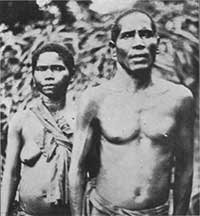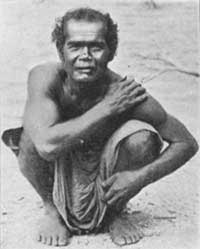
Photographic Anthropological Portraits
in British Scientific Journals, 1860-1930
- Valérie Morisson
_______________________________

Fig. 4. Seman man and woman, JAIGBI, 1902 

Most illustrations do not follow scientific recommendations. The set of portraits illustrating a 1904 article by J. Deniker on the diversity of the European population and printed on a single page, display very different semiological characteristics: the double portraits of a Portuguese and a South Bulgarian follow anthropometric codes but other bust portraits are expressive individualized studio portraits or cartes-de-visites [46]. The precise captions describing racial sub-groups compensate the unscientific nature of this sundry collection of photographs. The author certainly used what photographic source he had at his disposal, disregarding semiotic relevance and scientific codes. Strange hybrid images, the symptoms of a “visual slippage, in terms of function, between scientific and aesthetic photographic discourses” [47], were common. Other studio photographs are used in the articles published in the Journal [48]. In these cases, the sitters become scientific “specimens” only because the caption directs the processes of interpretation.
The overall scarcity of anthropometric portraits in the Review may be accounted for by several factors. As previously suggested, in spite of Bertillon’s and Galton’s endeavours to guarantee objectivity through new series of codes and methods, it became clear that photography enhanced rather than erased individual particularities [49]. Besides, concerns emerged over the quality of evidence produced by fragmented photographic surveys [50]. Photography was also said to be too dependent on lighting [51]. Its use in anthropology was debated both among the members of photographic societies and among anthropologists [52]. As early as 1882, one could read that “photographic portraits do not, as a fact, assist materially in the definition of racial characteristics.” [53] Later on, Franz Boas, the American pioneer of modern anthropology, challenged the alleged realism of anthropometric photography [54]. Even before the slow demise of anthropometry, the use of anthropometric portraits triggered much scepticism.
The gradual disappearance of anthropometric type portraits is also due to a growing awareness that population movements had altered ethnic purity and that pure specimens were rare. In a 1902 article on “The Kanets of Kulu and Lahoul, Punjab,” the author emphasizes “racial modification due to ethnic fusion” as foreign blood had undermined the purity of the group, concluding that a large number of types are necessary to analyse the caste [55]. Together with tables and figures, photographs are published but they are group portraits rather than individual ones, facilitating the perception of common physiological traits. They are commented on by the author in a section entitled “Explanation of Plates,” confirming that photographs remain subservient to and dependent on text. The photographs, which were taken by Holland himself, are not presented as tools for the acquisition of anthropometric data but are used as illustrations having nonetheless an evidential role when combined with text. In a 1903 article by T.A. Joyce [56], in which the many measurement tables are complemented by group portraits, photography is used to the same purpose. The distance from which the photographs are taken, the uniformity of costumes and poses, as well as the beards, enhance the physiological homogeneity of the clan.
The third reason for the scarcity of anthropometric portraits is the gradual awareness that the rigidity of the poses distorted the figures. Alfred Cort Haddon, one of the leading anthropologists at the time, and a member of the 1898 Anthropological Expedition to the Torres Strait, included more individualized type portraits in his accounts. He wrote:
Some portraits should be taken three-quarter view or in a position that gives a more pleasing picture than the stiff portraits required by the student. (…) Some unarranged groups should be taken instantaneously so as to get perfectly natural attitudes, for it must never be forgotten that when a native is posed for photography he unconsciously becomes set and rigid, and the delicate “play” of the limbs is lost [57].
In the same volume, J. G. Garson stated that “a definite description of the countenance under any emotion or frame of mind, with a statement of the circumstances under which it occurred, would possess much value. For such investigations a “snap shot” camera will be found of great assistance when it can be used.” Garson stresses that the production of anthropological photographs is an arduous task due to the transportation of heavy equipment, the strenuous measuring, the strict instructions, and the sitters’ reluctance. Following these lines of argument, some articles from the Review, replete with physical observations and measurement tables, are illustrated with more natural anthropological type-portraits. In “Some Preliminary Results of an Expedition to the Malaya Peninsula” by N. Annandale and H.C. Robinson, a Seman man and woman, and a Siamese man are photographed in lively poses (figs 4 and 5) [58]. Rather than homogenizing the population, the two authors describe small tribes that have developed different ways of life and racial features. They note that “measurements, more or less complete, of about four hundred individuals were obtained, about ninety of our subjects being representatives of the wild tribes” and add that conforming to the British Association’s rules was “impracticable.” [59] Though anthropometric portraits were quickly abandoned, the juxtaposition of two bust portraits, one in a frontal position, the other one in profile, remained extensively used even in the 1930s [60].
Ethnological and Anthropological Full-Length Portraits
By the end of the 19th century, photography had become “the salvage tool par excellence” owing to its indexical nature [61]. Its use was not restricted to anthropometry.
In an 1893 issue, E. F. Im Thurn advocated
the use of the camera for the accurate record, not of the mere bodies of primitive folk—which might indeed be more accurately measured and photographed for such [anthropometric] purposes dead than alive, could they be conveniently obtained when in that state—but of folk regarded as living beings [62].
He opposed the truthfulness of the photographic image to the ethnocentric bias in drawings:
Of old, the book illustrator, if, as was usual, he was not himself the traveller, drew as pictures of primitive folk, merely the men and women that surrounded him, and merely added to these such salient features as he was able, from the traveller’s tale, to fancy that his supposed primitive subjects had [63].
Im Thurn keyed the use of photography to salvage ethnology explaining that educated travellers should “put on permanent record, before it is too late” what they observed. He also complained about photographs that were made of natives transported to Europe arguing that, taken under non-natural conditions, they belied the true nature of the sitters who, due to the circumstances, looked dejected and shy [64]. Im Thurn concluded that
good and characteristic photographs of primitive folk in their natural condition are seldom to be obtained. Even in these days, when so many travelers carry cameras, and when a considerable number of these have skill in using their cameras, the photographs of natives thus obtained are neither as many nor as good as might be expected [65].
To provide scientifically useful photographs, living with the people and gaining their confidence was thus necessary [66]. In this article, the photograph of a reclining young man is accompanied by a caption which names the sitter: “Gabriel, the child of a red-skinned mother, a Warrau, and a black father.” The caption and the text show the anthropologist’s uncommon interest in individualized subjects. Im Thurn argues that photographs of subjects in natural situations can be more telling than words and extols “the great and wonderful powers of the camera.” [67] He also encourages the practice of photography to document the use of objects [68].
[46] “Les Six Races composant la population actuelle de l’Europe”, JAIGBI, vol. 34, July-December 1904, pp. 181-206.
[47] Edwards, 2001, Op. cit., p. 143.
[48] “The Teeth of Ten Sioux Indians”, Wilberforce Smith (JAIGBI, vol. 24, 1895, pp. 109-116) includes a photograph of a Sioux with the indication “Portrait from Cabinet Photograph.” In “Notes on the Samoyads of the Great Tundra” (JAIGBI, vol 24, 1895, pp. 388-410) the photographic portraits come from “The Great Frozen Land”, Messrs. Macmillan & Co., 1895.
[49] Edwards, 1990, p. 240 and Maresca, Op. cit., p. 71.
[50] Edwards, 2009, Op. cit., p. 82.
[51] W. H. Wesley noted as early as 1866: “Science owes much to photography, and photography is no doubt capable of much improvement; but I still think that the work of the artist will never be altogether dispensed with, nor be superseded by any merely mechanical process”, Journal of the Anthropological Society of London, vol. 4, pp. 120-126.
[52] Edwards, 2009, Op. cit., p. 89.
[53] Nature, A Weekly Illustrated Journal of Science, vol. 26, 1882, September 7.
[54] Ira Jenkins, “Franz Boas and Photography”, Studies in Visual Communications, 10:1, 1984, pp. 2-60.
[55] T. H. Holland, vol. 32, p. 96.
[56] “On the Physical Anthropology of the Oases of Khotan and Keriya”, JAIGBI, vol. 33, 1903, pp. 305-324.
[57] Notes and Queries, A. Cort Haddon, Third Edition, 1889, Photography Section, p. 239.
[58] JAIGBI, vol. 32, 1902, pl. XL, fig 1, 2 and 3.
[59] Ibid, p. 407.
[60] See “Notes on the Tribes Inhabiting the Baringo District, East Africa Protectorate” (JRAIGBI, vol. 40, 1910, pp. 49-72); Winfried Tucker and Charles S. Myers “A Contribution to the Anthropology of the Sudan” (JRAIGBI, vol. 40, 1910, pp. 141-163); H. Ian Hogbin, “Tribal Ceremonies at Ongtong Java, Solomon Islands” (JRAIGBI, vol. 62, 1932, pp. 27-55) where the author writes a lively account of ceremonies but accompanies his text with pseudo-anthropometric portraits, which may suggest that the placing of such images had become a mere convention.
[61] Edwards, 2009, Op. cit., p. 83.
[62] “Anthropological Uses of the Camera”, JAIGBI, vol. 22, 1893, pp. 184-203.
[63] Ibid., p. 185.
[64] Ibid.
[65] Ibid., pp. 186-187.
[66] Ibid.
[67] Ibid., p. 189.
[68] Ibid., p. 197.


